
|
|
March 11, 2011
Milwaukee, Racine and Kenosha, Wisconsin, 2009
Over the last five years, this column has crisscrossed the Badger State several times. There was the Big Trip of 2005 that covered most of Wisconsin's big markets, a return trip to Madison and Milwaukee in 2007, and the 2009 visit that we've been chronicling for the last few weeks.
In this last installment of our 2009 Wisconsin journey, we head south from Sheboygan (as seen last week) on the long drive back to Indiana, but not without a few stops along the way.
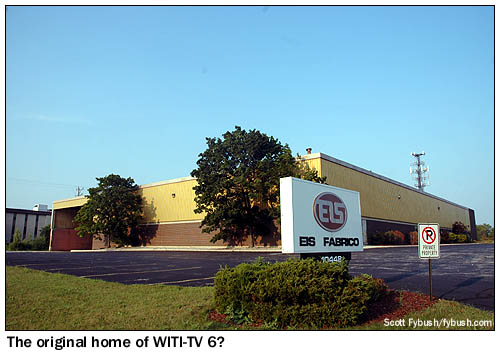 The
first one comes just north of Milwaukee, where we detour off
I-43 to pay our respects to...a generic-looking industrial building?
The
first one comes just north of Milwaukee, where we detour off
I-43 to pay our respects to...a generic-looking industrial building?
There's nothing very exciting now about the squat building at the northeast corner of Donges Bay and Port Washington roads, but there's history here, and lots of it: as best I can tell, this very building (or at least the site it sits on) was the birthplace of Milwaukee's third VHF station, WITI-TV, channel 6.
(Further research on HistoricAerials.com suggests that the actual WITI building may have been another structure just to the north of this one, and that much of the property was subsequently taken for the construction of I-43. We'll have to go back and look again next time we're in the area...)
As the late Dick Golembiewski chronicled in his exhaustive volume, Milwaukee Television History: The Analog Years, the channel 6 allocation was shoehorned into Milwaukee in 1953 by way of some shuffling (Green Bay from 6 to 5, Marquette, Michigan from 5 to 6, and a channel 6 allocation not to Milwaukee but to Whitefish Bay, just outside the 170-mile limits to channel 6 stations in Davenport and Lansing), and it took another three years for Independent Television, Inc. to get the new signal on the air from this very site in Mequon, Wisconsin.
There was a 1,046-foot guyed tower here, shared by WITI and educational station WMVS (Channel 10), and a most unusual studio system: instead of bright lights and traditional cameras, WITI was an early adopter of DuMont's "Vitascan" system, which used a set of flying-spot scanners in a completely darkened studio to generate color pictures much more cheaply than the RCA color cameras of the day. A strobe light synchronized to flash only during the vertical scan interval provided just enough light for the talent to see what they were doing, though Golembiewski reports it was difficult to work with and extremely disconcerting for studio guests.
Vitascan didn't last, and neither did this site: having sufficiently established the pretense of local service to Whitefish Bay and - more to the point - having secured the CBS affiliation from the Eye network's own struggling UHF outlet, WXIX (Channel 18), WITI felt free to move its studios into Milwaukee in 1959, taking over the building at 5445 N. 27th Street that had been home to UHF pioneer WCAN-TV (Channel 25). Three years later, the Mequon site was abandoned entirely, as WITI (by then an ABC affiliate) and WMVS moved their transmitters to a new 1,078-foot self-supporting tower off Capitol Drive, just down the street from the city's first TV station, WTMJ-TV.
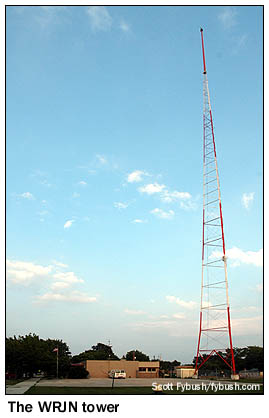 Today,
there's nothing left in Mequon to reflect this site's early TV
heritage: no sign of the tower, no plaque to memorialize the
ill-fated Vitascan system, just some fading memories - and some
great stories in Dick's book (which is well worth spending some
time with.)
Today,
there's nothing left in Mequon to reflect this site's early TV
heritage: no sign of the tower, no plaque to memorialize the
ill-fated Vitascan system, just some fading memories - and some
great stories in Dick's book (which is well worth spending some
time with.)
(We've shown you the other pieces of this history in previous Milwaukee visits: the N. 27th Street studio building and its successor, here, and the second WITI tower, here.)
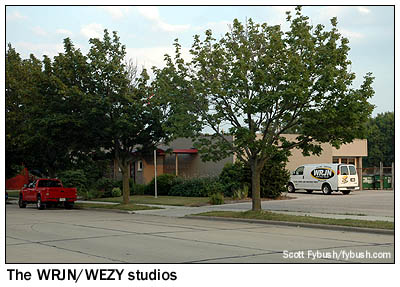
From Mequon, we bypass Milwaukee proper (having seen plenty of its sites on our 2005 and 2007 trips), instead chasing what's left of this Saturday's daylight as we head for a few sites south of Milwaukee that we've missed on previous visits.
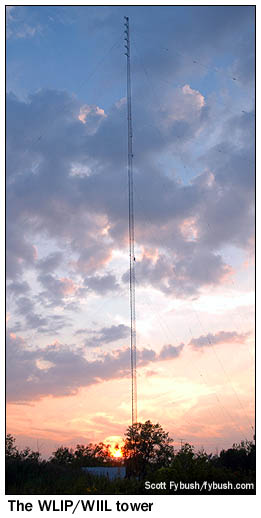 Racine
is the first decent-sized city south of Milwaukee, and it's just
large enough to sustain a couple of radio stations that are more
than just rimshots serving the big city to the north.
Racine
is the first decent-sized city south of Milwaukee, and it's just
large enough to sustain a couple of radio stations that are more
than just rimshots serving the big city to the north.
Bliss Communications owns news-talk WRJN (1400) and AC WEZY (92.1), which have studios in a residential neighborhood on Victory Avenue, right next to the WRJN tower. WRJN is an old, old station, dating back to the 1920s (it was once owned by the Racine Journal-News, hence the callsign), and it continues to super-serve its community, with lots of local talk (including an afternoon show hosted by our old New England pal Pete Ferrand!)
What's now WEZY came along in 1962; its current transmitter site is along I-94, out to the west of downtown Kenosha and the AM site.
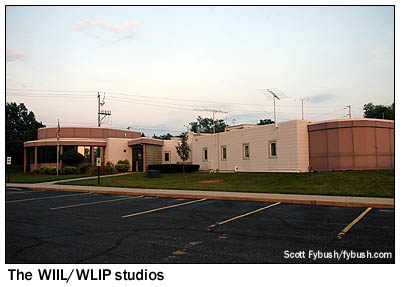
And our final stop before dark comes at the last AM station before the Illinois line: WLIP (1050 Kenosha) is a 250-watt fulltimer playing standards, and it's part of a two-station NextMedia group that's dominated by "WIIL Rocks." WIIL (95.1) is a class B FM signal that was long licensed to Kenosha; not long after our visit, it relicensed to Union Grove, moving it just over the county line to Racine County and thus taking WIIL out of NextMedia's market cap for the Chicago market without actually relocating the station's facilities.
That's it for the sites we saw in Wisconsin in 2009, but there's still one more installment of audio from the trip. Tune in Wednesday on TopHour.com...
 - Find out when the new Tower Site is posted,
and much more! Follow us on Twitter @NERadioWatch - and don't miss your chance to order the all-new
Tower Site Calendar 2011, now on CLEARANCE at the Fybush.com store!
- Find out when the new Tower Site is posted,
and much more! Follow us on Twitter @NERadioWatch - and don't miss your chance to order the all-new
Tower Site Calendar 2011, now on CLEARANCE at the Fybush.com store!- Previous Site of the Week: Sheboygan, Wisconsin, 2009
- Next Week: Indianapolis, 2009, part I
- Site of the Week INDEX!
- How can you help support Site of the Week? Click here!
- Submit your suggestions for a future Site of the Week!

